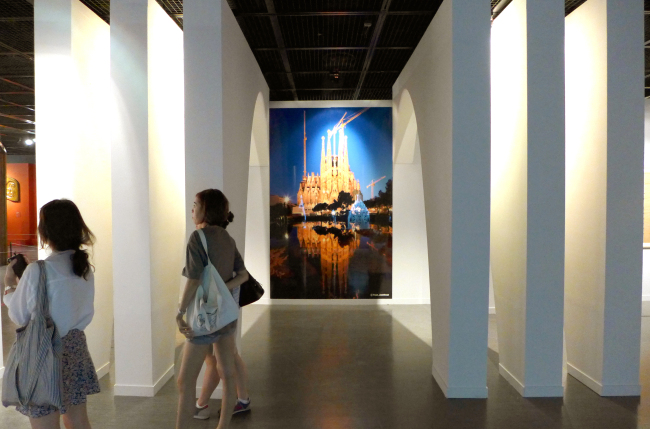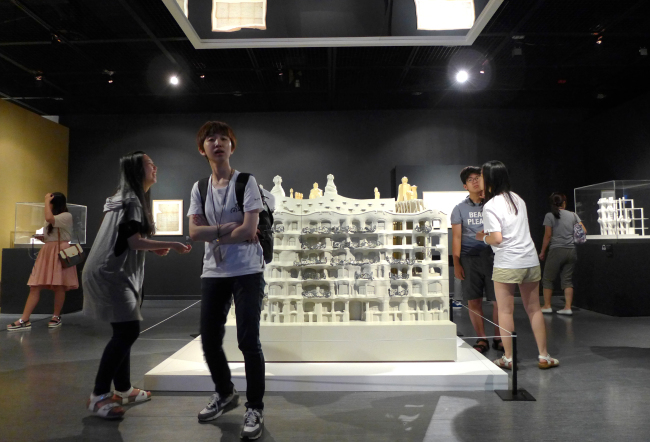Renowned Spanish architect and designer Antoni Gaudi (1852-1926) famously said: “The straight line belongs to men, the curved one to God.”
The surreal, curvaceous contours of his boundless imagination are on display at an exhibition titled “Unique Gaudi. Barcelona” at the Seoul Arts Center’s Hangaram Art Museum from July 3-Nov. 11.
A total of 170 works including sketches, sculptures, furniture, paintings, ceramics and mock-up models selected from various organizations in Spain showcase the ingenious designs of the great thinker, whose motifs emanated from nature, biology and religion.
The surreal, curvaceous contours of his boundless imagination are on display at an exhibition titled “Unique Gaudi. Barcelona” at the Seoul Arts Center’s Hangaram Art Museum from July 3-Nov. 11.
A total of 170 works including sketches, sculptures, furniture, paintings, ceramics and mock-up models selected from various organizations in Spain showcase the ingenious designs of the great thinker, whose motifs emanated from nature, biology and religion.

Throughout the exhibition’s six sections, participants can walk through the architect’s lifelong overview, student works, early projects, relationship with patron Eusebi Guell, residential designs, furniture and craft, his magnus opus the Temple of the Sagrada Familia, as well as works by Spanish painter Joan Miro devoted to Gaudi.
“Despite many exhibitions on Gaudi in Korea, there has never been one so sweeping in its coverage of works across the architect’s entire life period,” said CEO of Architwins Lee Byung-gi at the opening reception on Friday.
“Gaudi’s work was not simply a representation of nature, but a product of concerted efforts to materialize life’s vitality into built forms ― mainly stones ― with practical considerations. He tried to express ethereality in reality.”

Gaudi exemplified Catalan Modernism, which sought the revival of Catalan culture in the context of turn-of-the-century modernization, urbanization and industrialization. Under the influence of neo-Gothic and Oriental techniques, Gaudi incorporated organic forms into the mainstream modernism of the late 19th and early 20th centuries, which stirred Europe physically and psychologically.
He is also famous for his “god-like details” on ornamentation, merging ceramics, stained glass, ironwork and carpentry crafts with his architecture.
Lee noted that six of the seven buildings by Gaudi, which are on the UNESCO World Heritage list ― Parque Guell, Palacio Guell, Casa Mila, Casa Vicens, Casa Batllo, Crypt in Colonia Guell, and Gaudi’s work on the Nativity facade and Crypt of La Sagrada Familia ― represented Spain’s six social classes in his time.

“These energetic entrepreneurs were the vanguards of social and economic change, and wanted their buildings to embody their lofty aspirations,” Lee explained.
“Their guiding values being nationalism, revolution, bohemianism, energy, expansion and the like, these landlords revolutionized traditional gothic architecture into modernistic and rational structures.”

Gaudi’s Catholic faith grew stronger throughout his life, leading to religious images in his works. This earned him the nickname “God’s Architect,” and prompted calls for his beatification in recent years.
The venue was organized by the Michuhol Art Center, Aurea Cultura I Art and Catedra Gaudi at Universidad Politecnica de Cataluna ― a research institution specializing in collecting, studying and disseminating Gaudi’s work. CCOC and Contents House International sponsored the event, along with the Spanish Embassy in Korea, Architwins and Sohnminar & Co.
By Joel Lee (joel@heraldcorp.com)
-
Articles by Korea Herald




![[Music in drama] Rekindle a love that slipped through your fingers](http://res.heraldm.com/phpwas/restmb_idxmake.php?idx=644&simg=/content/image/2024/05/01/20240501050484_0.jpg&u=20240501151646)

![[New faces of Assembly] Architect behind ‘audacious initiative’ believes in denuclearized North Korea](http://res.heraldm.com/phpwas/restmb_idxmake.php?idx=644&simg=/content/image/2024/05/01/20240501050627_0.jpg&u=20240502093000)




![[KH Explains] Will alternative trading platform shake up Korean stock market?](http://res.heraldm.com/phpwas/restmb_idxmake.php?idx=644&simg=/content/image/2024/05/01/20240501050557_0.jpg&u=20240501161906)







![[Today’s K-pop] Stray Kids go gold in US with ‘Maniac’](http://res.heraldm.com/phpwas/restmb_idxmake.php?idx=642&simg=/content/image/2024/05/02/20240502050771_0.jpg&u=)